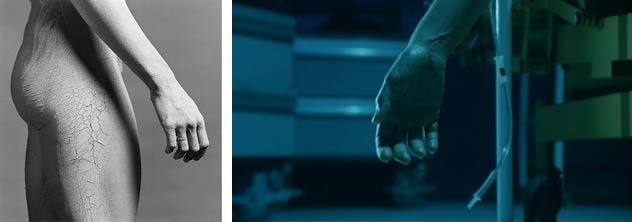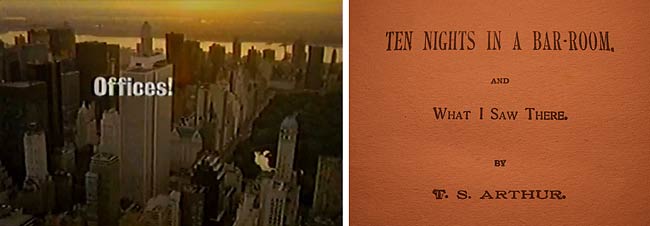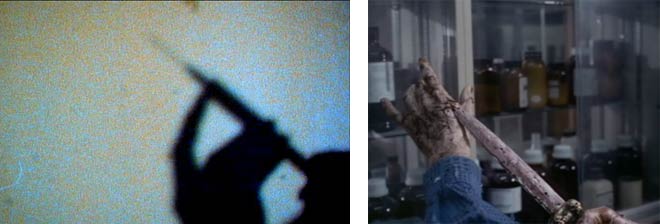
In the community of believers, paranormal sexual encounters are known as “spectrophilia.” Whether it’s invisible kisses and caresses, sex with Satan, phantom fornication, or obscene phone calls from the dead, let’s explore some claims of anomalous amorous phenomena.
{ Skeptical Inquirer | Continue reading }
sex-oriented, weirdos |
April 15th, 2011

The goal to be reached is the mind’s insight into what knowing is. Impatience asks for the impossible, wants to reach the goal without the means of getting there. The length of the journey has to be borne with, for every moment is necessary; and again we must halt at every stage, for each is itself a complete individual form, and is fully and finally considered only so far as its determinate character is taken and dealt with as a rounded and concrete whole, or only so far as the whole is looked at in the light of the special and peculiar character which this determination gives it.
{ Hegel, The Phenomenology of the Spirit, 8, 29, 1807 | Continue reading }
images { 1. Robert Mapplethorpe | 2 }
hegel |
April 15th, 2011

The world’s 6,000 or so modern languages may have all descended from a single ancestral tongue spoken by early African humans between 50,000 and 70,000 years ago, a new study suggests.
The finding, published Thursday in the journal Science, could help explain how the first spoken language emerged, spread and contributed to the evolutionary success of the human species. (…)
The origin of early languages is fuzzier. Truly ancient languages haven’t left empirical evidence that scientists can study. And many linguists believe it is hard to say anything definitive about languages prior to 8,000 years ago, as their relationships would have become jumbled over the millennia.
{ WSJ | Continue reading }
Linguistics, flashback |
April 15th, 2011

JamesMTitus was manufactured by cyber-security specialists in New Zealand participating in a two-week social-engineering experiment organized by the Web Ecology Project. Based in Boston, the group had conducted demographic analyses of Chatroulette and studies of Twitter networks during the recent Middle East protests. It was now interested in a question of particular concern to social-media experts and marketers: Is it possible not only to infiltrate social networks, but also to influence them on a large scale?
The group invited three teams to program “social bots”—fake identities—that could mimic human conversation on Twitter, and then picked 500 real users on the social network, the core of whom shared a fondness for cats. The Kiwis armed JamesMTitus with a database of generic responses (“Oh, that’s very interesting, tell me more about that”) and designed it to systematically test parts of the network for what tweets generated the most responses, and then to talk to the most responsive people.
After the first week, the teams were allowed to tweak their bot’s code and to launch secondary identities designed to sabotage their competitors’ bots.
{ The Atlantic | Continue reading }
scams and heists, social networks, technology |
April 15th, 2011

images { 1 | 2 }
economics, ideas, technology |
April 15th, 2011

Tech bubbles happen, but we usually gain from the innovation left behind. This one—driven by social networking—could leave us empty-handed
As a 23-year-old math genius one year out of Harvard, Jeff Hammerbacher arrived at Facebook when the company was still in its infancy. This was in April 2006, and Mark Zuckerberg gave Hammerbacher—one of Facebook’s first 100 employees—the lofty title of research scientist and put him to work analyzing how people used the social networking service. Specifically, he was given the assignment of uncovering why Facebook took off at some universities and flopped at others. The company also wanted to track differences in behavior between high-school-age kids and older, drunker college students. “I was there to answer these high-level questions, and they really didn’t have any tools to do that yet,” he says.
Over the next two years, Hammerbacher assembled a team to build a new class of analytical technology. His crew gathered huge volumes of data, pored over it, and learned much about people’s relationships, tendencies, and desires. Facebook has since turned these insights into precision advertising, the foundation of its business. (…)
After a couple years at Facebook, Hammerbacher grew restless. He figured that much of the groundbreaking computer science had been done. Something else gnawed at him. Hammerbacher looked around Silicon Valley at companies like his own, Google, and Twitter, and saw his peers wasting their talents. “The best minds of my generation are thinking about how to make people click ads,” he says. “That sucks.” (…)
Hammerbacher quit Facebook in 2008, took some time off, and then co-founded Cloudera, a data-analysis software startup. He’s 28 now and speaks with the classic Silicon Valley blend of preternatural self-assurance and save-the-worldism. (…) He’s not really a programmer or an engineer; he’s mostly just really, really good at math. (…)
On Wall Street, the math geeks are known as quants. They’re the ones who create sophisticated trading algorithms that can ingest vast amounts of market data and then form buy and sell decisions in milliseconds. Hammerbacher was a quant. After about 10 months, he got back in touch with Zuckerberg, who offered him the Facebook job in California. That’s when Hammerbacher redirected his quant proclivities toward consumer technology.
{ BusinessWeek | Continue reading }
economics, experience, science, technology |
April 15th, 2011

The American painter Barnett Newman once said that an artist gets from aesthetics what a bird gets from ornithology—nothing. (…)
There are things in our context that we readily recognize to be art because they are sufficiently like it in relevant respects—even though they may not “look like art” in every respect. What is this form of life in which this likeness can be seen? (…)
The notion that “vision itself has its history,” to use the words of Heinrich Wölfflin, has been one of the longest-lasting and deepest- seated principles of art history, even if it has sometimes been somewhat subterranean.
{ Whitney Davis, A General Theory of Visual Culture | Continue reading | PDF }
photo { Richard Ross, Field Museum of Natural History, Chicago, 1986 }
art, ideas |
April 13th, 2011

Physicians may choose riskier treatment for themselves than they’d recommend for their patients, according to a study that highlights a need for candid discussions about patients’ preferences.
The findings are important because patients faced with difficult medical decisions often ask their doctors, “What would you do?” The answer reflects the doctors’ values — not necessarily those of the patient. (…)
The study asked more than 700 primary-care doctors to choose between two treatment options for cancer and the flu — one with a higher risk of death, one with a higher risk of serious, lasting complications.
In each of the two scenarios, doctors who said they’d choose the deadlier option for themselves outnumbered those who said they’d choose it for their patients. (…)
Previous research shows many people would react in a similar emotional way when presented with difficult choices for themselves versus others.
For example, one study asked participants if they would approach an attractive stranger in a bar if they noticed that person was looking at them. Many said no, but they would give a friend the opposite advice. Saying “no” meant avoiding short-term pain — possible rejection by an attractive stranger — but also missing out on possible long-term gain — a relationship with that stranger.
{ News & Records | Continue reading }
screenshots { 1 | 2 }
psychology |
April 13th, 2011

In the present study 24 university students read four different texts in four conditions:
(1) while listening to music they preferred to listen to while studying;
(2) while listening to music they did not prefer to listen to while studying;
(3) while listening to a recording of noise from a café; and finally
(4) in silence.
After each text they took a reading-comprehension test. Eye movement data were recorded for all participants in all conditions.
A main effect for the reading-comprehension scores revealed that the participants scored significantly lower after they had been listening to the non-preferred music while reading, compared with reading in silence.
{ SAGE | Continue reading }
photo { Kyoko Hamada }
music, neurosciences |
April 13th, 2011

Anecdotal reports suggest that some users of ecstasy (MDMA) experience increased feelings of empathy and are more social while under influence of the drug. Such effects may contribute to the timing and frequency of ecstasy use and may also contribute to risk of abuse or dependence. Understanding this phenomenon in more detail might provide clinicians with better strategies to reduce use and the associated complications of ecstasy use.
Studying acute effects of illicit drugs is difficult under natural conditions. Users of ecstasy commonly also use alcohol, nictoine and other illicit drugs in the context of ecstasy use. Isolating psychological effects of one agent in this type of environment is difficult if not impossible. One alternative is to admiinster ecstasy in a laboratory setting with subjects blind to whether ecstasy or placebo is being administered. However, this approach poses significant ethical challenges. One approach, is to limit human study in the lab to those who have previously use ecstasy and intend to continue using. (…)
A study in Biological Psychiatry took this approach when over four sessions, healthy ecstasy using volunteers received either a low or high dose of MDMA, a dose of methamphetamine (METH) or placebo. (…)
Findings suggest MDMA increases social approach (sociability). The study supports the possibility that increased social behavior with MDMA might be due to a reduced sensitivity to negative emotions of others rather than increasing recognition of positive emotions in others.
{ Brain Posts | Continue reading }
photo { Noritoshi Hirakawa }
drugs, neurosciences, photogs, relationships |
April 13th, 2011
Numerous studies in recent years have reported that drinking coffee may be good for the cardiovascular system and might even help prevent strokes. Just last month, Swedish researchers announced results of a large study showing that coffee seemed to reduce the risk of stroke in women by up to 25%. (…)
A 2008 study of more than 26,000 male smokers in Finland found that the men who drank eight or more cups of coffee a day had a 23% lower risk of stroke than the men who drank little or no coffee. And a few other reports suggest the effect applies to healthy nonsmokers too.
{ LA Times | Continue reading }
food, drinks, restaurants, health |
April 13th, 2011

Social convention of 1884, when FDR was photographed at age 2 1/2, dictated that boys wore dresses until age 6 or 7, also the time of their first haircut. Franklin’s outfit was considered gender-neutral.
But nowadays people just have to know the sex of a baby or young child at first glance, says Jo B. Paoletti, a historian at the University of Maryland and author of Pink and Blue: Telling the Girls From the Boys in America. (…)
For centuries, children wore dainty white dresses up to age 6. (…) The march toward gender-specific clothes was neither linear nor rapid. Pink and blue arrived, along with other pastels, as colors for babies in the mid-19th century, yet the two colors were not promoted as gender signifiers until just before World War I—and even then, it took time for popular culture to sort things out.
{ Smithsonian Magazine | Continue reading }
colors, flashback, genders, kids |
April 13th, 2011

A new study from the U.K. confirms the conventional wisdom: friends and exercise make us happy. It also shows how unhappy people drag us down.
{ The Atlantic | Continue reading }
photo { Jim Britt }
marketing, photogs, psychology |
April 12th, 2011

If beautiful people have more daughters, and if physical attractiveness is heritable, then it follows that, over time, women become physically more attractive than men. This indeed appears to be the case.
The logic of the generalized Trivers-Willard hypothesis (gTWH) suggests that physically more attractive parents are more likely to have daughters than physically less attractive parents. (…)
Earlier studies indeed show that women are on average physically more attractive than men both in Japan and in the United States. Analysis of the NCDS data now replicates the sex difference in physical attractiveness in the United Kingdom.
{ PsychologyToday | Continue reading }
genders, science |
April 12th, 2011

{ How food-breaks sway the decisions of judges. The graph above shows that the odds that prisoners will be successfully paroled start off fairly high at around 65% and quickly plummet to nothing over a few hours (although, see footnote). After the judges have returned from their breaks, the odds abruptly climb back up to 65%, before resuming their downward slide. | Discover | full story }
food, drinks, restaurants, law, psychology |
April 12th, 2011
Forget passwords, tricky sums are more secure
Classic user identification requires the remote user sending a username and a password to the system to which they want to be authenticated. The system looks up the username in its locally stored database and if the password submitted matches the stored password, then access is granted. This method for identification works under the assumption there exist no malicious users and that their local terminals cannot be infected by malware. (…)

Nikolaos Bardis of the University of Military Education, in Vari, Greece and colleagues there and at the Polytechnic Institute of Kiev, in Ukraine, have developed an innovative approach to logins, which implements the advanced concept of zero knowledge identification.
Zero knowledge user identification solves these issues by using passwords that change for every session and are not known to the system beforehand. The system can only check their validity.
{ ScienceText | Continue reading }
mathematics, spy & security, technology |
April 12th, 2011

Remember Paul Ceglia? He’s the fellow in upstate New York who sued Mark Zuckerberg last July, claiming that, way back in 2003, Zuckerberg had agreed to give him a 50% ownership in the project that became Facebook.
That claim seemed preposterous at the time, not least because Ceglia had waited 7 years to file it. And there was also the fact that Ceglia was a convicted felon, having been charged with criminal fraud in connection with a wood-pellet company he operated. (…)
But now Paul Ceglia has refiled his lawsuit. With a much larger law firm. And a lot more evidence. And the new evidence is startling.
{ Business Insider | Continue reading }
economics, law, social networks |
April 12th, 2011

Suicide Gene Identified
The study evaluated the entire genomes of patients with bipolar disorder who had attempted suicide (n=1201) and those who had not (n=1497). In total, there were more than 2500 regions located on various chromosomes that showed significant associations with suicidal behavior. The strongest association was with a region on chromosome 2 containing the ACP1 gene. This gene encodes for a signaling protein (tyrosine phosphatase) produced in the brain.
{ BrainBlogger | Continue reading }
photo { Sophia Wallace }
genes, science |
April 12th, 2011

In recent years several studies have suggested that women’s voices change at different times over the menstrual cycle, with the tone rising as ovulation approaches.
Now a study conducted by researchers at the West Texas A&M University in which women’s voices were subjected to computerized acoustical analysis contradicts those findings.
After assessing 175 samples provided by 35 study participants at various points throughout the menstrual cycles, the researchers say that changes in hormonal status have no significant impact on eight distinct voice parameters.
{ EurekAlert | Continue reading }
photo { Zev Jonas }
genders, horse, science |
April 11th, 2011





















